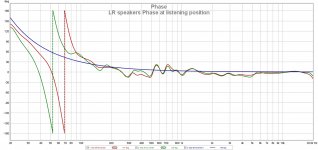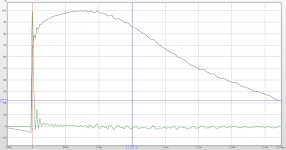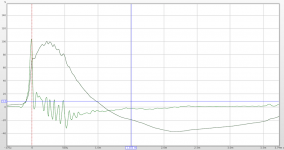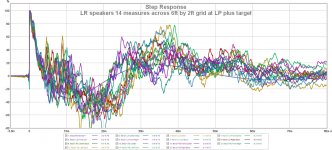If one models the phase response of an "ideal" speaker, it is similar to the blue curve in the chart below. Of course, it depends on the low frequency cutoff and roll off slope for any particular speaker system, but if you play with different low frequency box alignments, the phase shape is more or less the same.

The red and green traces are my speakers measured at the listening position some 9 to 11 feet away. I used FDW and psychoacoustic smoothing in REW as it closely matches the correction settings used for the DSP FIR filtering.
I have experimented with just linearizing the phase in a 3 way system with a passive XO and must say I did not notice a huge improvement when I switched the filter in and out while listening to music in real time. However, when I time aligned the drivers using linear phase digital XO and then corrected the excess phase, I noticed a considerable improvement in the "depth of field" in listening. Almost like the sound went from 2D to 3D.
I am wondering if this is the same sense that wesayso and others with line arrays are hearing as these types of speakers are inherently time aligned and have no XO to mess with different time arrivals and phase...
Thoughts?
The red and green traces are my speakers measured at the listening position some 9 to 11 feet away. I used FDW and psychoacoustic smoothing in REW as it closely matches the correction settings used for the DSP FIR filtering.
I have experimented with just linearizing the phase in a 3 way system with a passive XO and must say I did not notice a huge improvement when I switched the filter in and out while listening to music in real time. However, when I time aligned the drivers using linear phase digital XO and then corrected the excess phase, I noticed a considerable improvement in the "depth of field" in listening. Almost like the sound went from 2D to 3D.
I am wondering if this is the same sense that wesayso and others with line arrays are hearing as these types of speakers are inherently time aligned and have no XO to mess with different time arrivals and phase...
Thoughts?
Attachments
.....Thoughts?
Looks great and guess what we like to see after throwing DSP control into system, the impressing thing your case verse most other multi way systems is data taken at listening position and therefor guess performance is same sense or close to wesayso and fluid's line arrays, guess must sound very good so enjoy and many thanks sharing good stuff including interesting reviews and writing at other domain
When I compare Frequency Dependent Windowing to Psychoacoustic smoothing in REW the issues in the response seem to flip around, they are dips with FDW and bumps with Psycho smoothing, do they look the same to you?Thoughts?
It seems logical that if the base speaker is more accurate in the time domain then excess phase correction would work better. I removed the last bit of excess phase below 100Hz with a manual rephase filter and it made a noticeable difference to the impact of kick drums. It took a bit of trial and error to find the right amount, it was easier to make worse than make better
Reality is not as bad as you imagine.How can a linearray be timealigned at HF and nearfield when the drivers are not individually time alligned?
This is an outdoor measurement of my uncorrected array, impulse and step
After correction indoors
Attachments
How can a linearray be timealigned at HF and nearfield when the drivers are not individually time alligned?
By abusing of 2D graphs and mathematical abstractions.
By abusing of 2D graphs and mathematical abstractions.
500ms raw impulse response of a speaker outdoors with no processing is about as unvarnished and un-abused as you will get.
Lets not turn this thread into a line array debate.
By abusing of 2D graphs and mathematical abstractions.
Really? So what do you get out of RePhase?
Really? So what do you get out of RePhase?
Rephase is a tool, and exactly as mathematics, it is extremely tricky to get it totally pertinent and totally true.
For me, rephase is a learning tool.
That doesn't explain the abusing of 2D graphs to me... care to enlighten us?
I will not be more precise, I do not target anyone in particular, "us" neither.
Then I don't see the point of making such a remark. You started a discussion about CSD waterfalls... Here's one of the arrays:

Am I abusing the graphs with this? Here are the settings used in REW:

Rephase would teach me it should look like this:

Omitting the falling frequency that has my preference.

Am I abusing the graphs with this? Here are the settings used in REW:

Rephase would teach me it should look like this:

Omitting the falling frequency that has my preference.
Last edited:
Wider than 'one' might think. The IR won't really change left to right or up and down as it would with a more conventional multi way speaker. Perhaps best to ask BYRTT as I would likely give a biased answer. He has heard them in real life and sat in the sweet spot and beside that spot as well. He even hugged my speakers  .
.
The example above was based on an average of 4 measurements. That average is very close to the single center spot measurement.
Averaging will exhibit less influence of the room (averaging out the reflections), however my room was already optimized to work with the arrays and as a result has a lower than usual level of reflections because all the first reflections are being absorbed by big panels. Even an average measured along my entire couch is pretty much the same as the sweet spot measurement. Unless you'd fire both speakers at once . Lucky for us we have a head in between that the (at least my) microphone does not have.
. Lucky for us we have a head in between that the (at least my) microphone does not have.
A more conventional multi way speaker would change its behavior much more compared to an array due to the time differences between the separate drivers and our listening ear or microphone when one moves up or down.
It will also change how it interacts with the room when going up, down, left or right, unless you go to such lengths as the room responsible for the result I showed from jim1961(*). I have a huge respect for the work he did, all the sound that hits the listening spot is carefully planned in that room. I called it Studio like, which Jim would probably find insulting, because he planned it as a listening room, not the analytical room required to make decisions but to enjoy listening.
As fluid rightfully said, this is not the place to go deeper into the line array thing. I merely tried to get more than a few words loose from silverprout because it's quite easy to say things like: Rephase is a tool, and exactly as mathematics, it is extremely tricky to get it totally pertinent and totally true or By abusing of 2D graphs and mathematical abstractions but I don't think that's entirely fair to those of us that literary have spend years to figure out what works and what doesn't. I try and share to possibly help others and I learn from the generous sharing of others.
I guess one liners like that were a red blanket for me today, sorry for that.
This is the RePhase thread. One of it's merits for me is to be able to check how it should look theoretically by letting me create impulses of things I want to examine. I use it as a theoretical model creator/generator together with REW. I think BYRTT actually showed me the way to use it like that.
It's a great tool for many things. But the user should know and be aware of what he wants it to do.
(*) moving up and down in Jim's room would still alter the distances between the drivers and the listener and thus would still alter the result.
Moving left and right would depend on the speaker's off axis results.
The example above was based on an average of 4 measurements. That average is very close to the single center spot measurement.
Averaging will exhibit less influence of the room (averaging out the reflections), however my room was already optimized to work with the arrays and as a result has a lower than usual level of reflections because all the first reflections are being absorbed by big panels. Even an average measured along my entire couch is pretty much the same as the sweet spot measurement. Unless you'd fire both speakers at once
A more conventional multi way speaker would change its behavior much more compared to an array due to the time differences between the separate drivers and our listening ear or microphone when one moves up or down.
It will also change how it interacts with the room when going up, down, left or right, unless you go to such lengths as the room responsible for the result I showed from jim1961(*). I have a huge respect for the work he did, all the sound that hits the listening spot is carefully planned in that room. I called it Studio like, which Jim would probably find insulting, because he planned it as a listening room, not the analytical room required to make decisions but to enjoy listening.
As fluid rightfully said, this is not the place to go deeper into the line array thing. I merely tried to get more than a few words loose from silverprout because it's quite easy to say things like: Rephase is a tool, and exactly as mathematics, it is extremely tricky to get it totally pertinent and totally true or By abusing of 2D graphs and mathematical abstractions but I don't think that's entirely fair to those of us that literary have spend years to figure out what works and what doesn't. I try and share to possibly help others and I learn from the generous sharing of others.
I guess one liners like that were a red blanket for me today, sorry for that.
This is the RePhase thread. One of it's merits for me is to be able to check how it should look theoretically by letting me create impulses of things I want to examine. I use it as a theoretical model creator/generator together with REW. I think BYRTT actually showed me the way to use it like that.
It's a great tool for many things. But the user should know and be aware of what he wants it to do.
(*) moving up and down in Jim's room would still alter the distances between the drivers and the listener and thus would still alter the result.
Moving left and right would depend on the speaker's off axis results.
Last edited:
No worries, sometimes letting things go is, well.............it can't be done all the time.I guess one liners like that were a red blanket for me today, sorry for that.
BTW is "red blanket" a Dutch saying? In English "red rag"
I have not tried the same type of processing on a multiway so I can't answer but I imagine that the listening window would be smaller as I find the sound of my multiway speakers to change much more due to position.So I guess the same can be done with multiway, inside a small listening window (and a lot of work).
How large is the area/cube where the corrected arrays are perceived as time alligned?
Be prepared for a lot of work to get a good correction, it is much easier to make a mess of it than it is to get it right
There are many people who have very closed minds and rigid ideas about what works and what doesn't. I can see where some of these ideas come from and the reasons behind them but it doesn't often make for progress.I don't think that's entirely fair to those of us that literary have spend years to figure out what works and what doesn't. I try and share to possibly help others and I learn from the generous sharing of others.
I guess one liners like that were a red blanket for me today, sorry for that.
Rephase works great as a diagnostic and test tool, but it's also quite handy for making FIR filters, particularly those last little tweaks that make quite a difference.
It is only with the open sharing and discussing of ideas that progress can be made. I have learnt a lot from your posts and private communication and even though our opinions on some subjects are different the techniques that improved your system also improved mine so keep sharing
It seems the Dutch are very brave as they don't just wave a red rag at a Bull they use a whole blanket
Looks great and guess what we like to see after throwing DSP control into system, the impressing thing your case verse most other multi way systems is data taken at listening position and therefor guess performance is same sense or close to wesayso and fluid's line arrays, guess must sound very good so enjoy and many thanks sharing good stuff including interesting reviews and writing at other domain.
Cheers BYRTT!
When I compare Frequency Dependent Windowing to Psychoacoustic smoothing in REW the issues in the response seem to flip around, they are dips with FDW and bumps with Psycho smoothing, do they look the same to you?
No, they don't look the same to me either, as they are two different types of smoothing applied. I think @JohnM had some notes on these differences in the REW site/thread on FDW. It appears the FDW math is the same for several acoustic measurement programs, it is the psychoacoustic filtering that seems different for each of these programs.
So I guess the same can be done with multiway, inside a small listening window (and a lot of work).
How large is the area/cube where the corrected arrays are perceived as time aligned?
The time alignment listening window can be quite large for multiway's as well. Here is the step response of the same active 3-way I posted earlier, except I took 14 measures of both left and right speakers over a 6' x 2' grid which covers my couch area at the LP:
The drivers are time aligned over the 6' x 2' listening area as indicated by the vertical "step" overlay at t=0. Moving the height of the mic up and down by a foot each way, produces similar results. I have overlaid the "ideal" step response as well. The peaks at 4ms and 8ms are the bounce off the rear wall from the measurements that were taken near the back of the couch area. i.e. the mic is (much) closer in distance to the rear wall versus the distance to the speaker.
I like @SwissBear approach using REW and rePhase: Using REW and rephase to generate amplitude and time domain corrections - DSP, Room Correction, and Multi Channel Audio - Computer Audiophile
Thoughts?
Attachments
I wonder which is more "correct" thenNo, they don't look the same to me either, as they are two different types of smoothing applied.
It would in the vertical direction that I would expect the multiway changes more. Byrtt has shown before that by using very steep filters a multiway can get more even vertical response too. Probably not much of an issue if you always listen at the same height.The time alignment listening window can be quite large for multiway's as well.
In my system I have found that using a spatially averaged measurement across my couch in a similar way that SwissBear has written about here before is very useful to base a correction on. On a single measurement I would need to use significantly weaker correction to avoid it sounding "processed". I tested the same strong correction with a single measurement as the base and it was terrible.
My room is quite reflective and has zero treatment so in a treated room the differences might be less.
Wesayso,
Is the area about 600-1khz on your waterfall from your room or from the arrays? Is that a nearfield measurement or at the seating position? Just curious when I see something like that when I see you have quite a bunch of low end below that area of the response curve. Don't sweat it, this is the rePhase page anyway.
Is the area about 600-1khz on your waterfall from your room or from the arrays? Is that a nearfield measurement or at the seating position? Just curious when I see something like that when I see you have quite a bunch of low end below that area of the response curve. Don't sweat it, this is the rePhase page anyway.
Not wesayso but the blue graph is the array in room and the red one is a rephase generated "perfect" version of a band limited impulse for comparison.
The reason for the change at the bottom end is due to the window settings, the settings are optimised for the High Frequencies in those graphs.
Making the 600 to 1K look right would mean the HF would be off. That is the problem with waterfalls, you can't use the same settings for all frequencies, and then you have the trade off of frequency vs time resolution.
The reason for the change at the bottom end is due to the window settings, the settings are optimised for the High Frequencies in those graphs.
Making the 600 to 1K look right would mean the HF would be off. That is the problem with waterfalls, you can't use the same settings for all frequencies, and then you have the trade off of frequency vs time resolution.
- Home
- Design & Build
- Software Tools
- rePhase, a loudspeaker phase linearization, EQ and FIR filtering tool



